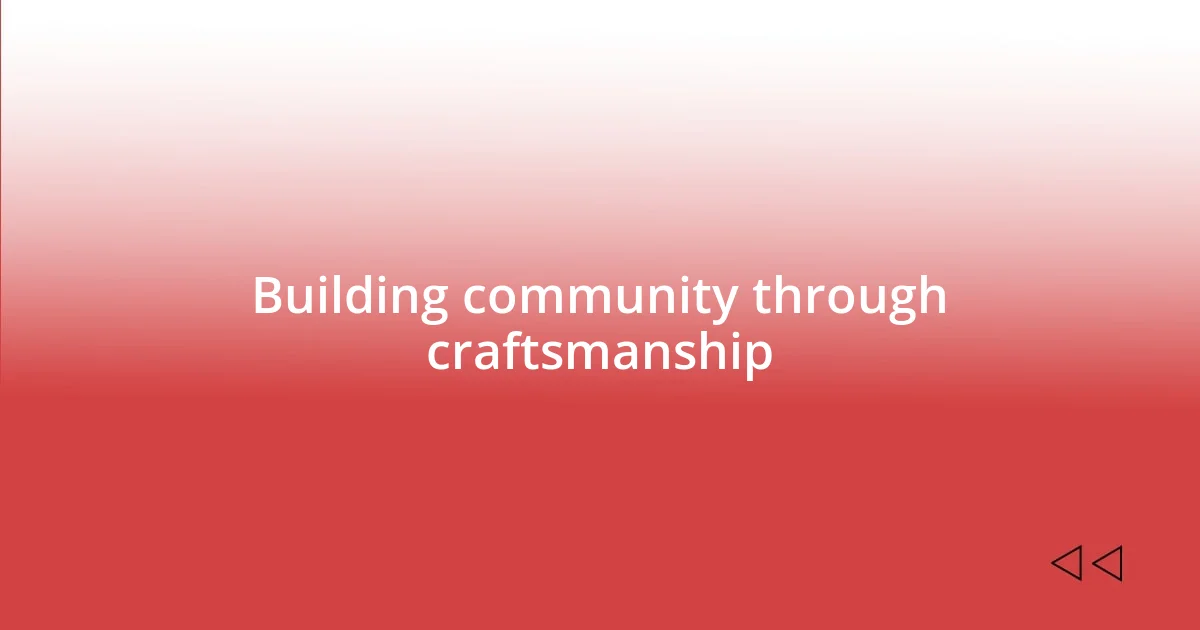Key takeaways:
- Local artisans share unique stories and craftsmanship that embody cultural heritage, fostering deep community connections.
- Traditional techniques are vital for preserving cultural identity and inspire innovation in art and design.
- Supporting artisans through conscious consumer choices not only uplifts individuals but enriches entire communities and keeps traditions alive.

What local artisans offered me
Local artisans offered me a treasure trove of unique perspectives. I remember standing in a small, dimly lit workshop, where an elderly potter shared the story behind each of his creations. His hands, calloused yet gentle, shaped the clay while he spoke about the significance of tradition. It made me wonder—how many stories go untold behind the art that surrounds us?
In addition to craftsmanship, these artisans imparted a sense of community. I still cherish the lively atmosphere at local markets; the laughter and chatter created a tapestry of connection. When I exchanged a mere smile with a weaver, it felt like I was woven into the very fabric of their world. Isn’t it fascinating how something as simple as a shared moment can create lasting bonds?
Their creative passion ignited something in me, too. After watching an artisan transform humble materials into breathtaking jewelry, I found myself inspired to explore my own creativity. Have you ever felt that spark of inspiration just by being in the presence of passionate people? It reminded me that art isn’t just about the finished product; it’s about the journey and the heartfelt stories behind each piece.

Skills shared by local artisans
Local artisans often showcase an incredible range of skills that reflect both their personal journey and cultural heritage. For instance, the meticulous attention to detail displayed by a local jeweler truly captivated me. As I watched her work, I realized that each tiny gemstone she set carried a story, a connection to the earth, and a passion for her craft. It’s amazing how skills like gem setting not only require technical knowledge but also an emotional commitment to the artistry involved.
Another skill that stood out was the craftsmanship of a skilled woodworker I visited. As he demonstrated his technique for hand-carving intricate designs, I felt a sense of admiration for the patience required in his craft. There’s a certain rhythm to his process, much like a dance—the way he moved through each cut was almost poetic. This experience made me reflect on how patience isn’t just essential in artistry; it’s a vital life skill that teaches us to embrace the journey rather than rush to the finish line.
Finally, I learned about the power of storytelling through an artisan specializing in textile weaving. Each pattern in her fabric held meanings passed down through generations, revealing tales of love, struggle, and resilience. Hearing her explain these stories made me realize that artisans do far more than create beautiful items; they serve as cultural historians, maintaining traditions and weaving threads of connection across time and space.
| Artisan Skill | Insight Gained |
|---|---|
| Jewelry Making | Every gem carries a story and a passion for the craft. |
| Woodworking | Patience in crafting reflects a deeper life lesson. |
| Textile Weaving | Artisans preserve cultural stories through their creations. |

Importance of traditional techniques
Traditional techniques hold immense value, serving as a bridge between generations. While observing a blacksmith forge metal, I felt the weight of history in each strike of his hammer. It struck me that these methods are not just about creating; they embody the technique, precision, and deep-rooted passion that artisans pass down through their families. Witnessing their dedication makes me appreciate the painstaking effort behind handcrafted items, and it reminds me that every piece has its own unique soul.
The commitment to traditional craft is also a source of identity for many artisans, as these techniques are often intertwined with cultural heritage. For instance, while learning about a ceramist’s practice, I was moved by how she merged ancient methods with her contemporary vision. I realized that:
- Traditional techniques preserve cultural heritage and identity.
- They teach us about patience and the value of craftsmanship.
- These methods inspire modern innovations in art and design.
Every time I see that beautiful pot she made, I think of the rich lineage of knowledge and the spirit of community that infuses her work. Isn’t it incredible how these age-old techniques allow us to connect with our past while inspiring our future?

Building community through craftsmanship
Craftsmanship truly serves as a glue that binds the community together. I often recall a recent visit to a local pottery studio, where artisans worked side by side, sharing tips and laughter. It was heartwarming to see how their camaraderie transformed the space—each pot spun on the wheel was not just a creation but a shared experience, reflecting the bonds of friendship forged through their craft. Isn’t it fascinating how these interactions can create a sense of belonging?
Moreover, I’ve noticed that local markets often become vibrant hubs for artisans to showcase their work and stories. Walking through those stalls, I felt an electric atmosphere, where creativity circulated like energy among the artisans and customers alike. It made me wonder: how can something as simple as craftsmanship become a narrative that brings people together? Each artisan, be it a sculptor or a painter, contributes to a collective identity; their pieces resonate with the community’s heartbeat, enriching our local culture.
On another occasion, I participated in a weaving workshop where the instructor emphasized the importance of mentorship. As she guided each of us in crafting our own pieces, I could sense generations of knowledge being shared in real time. The respect for one another’s efforts was palpable, creating an environment where everyone was celebrated. This experience reminded me that through craftsmanship, we not only build skills but also foster mentorship and support. What a powerful way to inspire future generations while strengthening the ties that hold a community together!

Unique products and their stories
As I strolled through a charming artisan market, I stumbled upon a basket filled with intricately woven textiles, each telling a different story. I couldn’t help but pick up a vibrant shawl adorned with geometric patterns that echoed the landscape of the mountains nearby. The artisan, a warm elderly woman, shared how each design reflected her childhood memories of her grandmother’s home, binding her family heritage into the fabric itself. It made me ponder: How often do we consider the histories imbued in the objects we cherish?
While visiting a local woodworker, I was captivated by the unique sound of the chisel meeting the wood. Each gentle tap seemed to resonate with a rhythm of its own, as he revealed the tale behind the stunning furniture pieces he crafted. He explained how his latest project was inspired by his grandfather’s workbench, a place filled with lessons and dreams. It struck me that these products are not just items for sale; they’re vessels of personal narratives that transport us to different times and places. Isn’t it beautiful how a simple chair can evoke feelings of warmth and nostalgia?
One day, I attended a candle-making workshop, and I was mesmerized by the way scents can weave stories of their own. I created a candle infused with lavender, reminiscent of summer evenings spent in my grandmother’s garden. As I poured the wax, I remembered her gentle hands guiding me among the flowers. That moment highlighted a profound truth: unique products are often personal reminders of our cherished experiences. Each candle we lit became a symbol of those memories, sparking joy and warmth that can only stem from heartfelt creation. How many stories do we hold in the objects that surround us?

Challenges faced by local artisans
Local artisans face a myriad of challenges that often go unnoticed. Delving into the artisan community, I found that many struggle with limited access to resources. For instance, a friend who crafts handmade jewelry shared how obtaining quality materials can sometimes feel like a daunting treasure hunt. Isn’t it disheartening to think that such talented individuals might be hindered simply by their inability to source the right tools or materials?
Moreover, there’s the constant battle against mass-produced items that flood the market. I once visited a local candle maker who lamented how cheaper, machine-made alternatives dominate the retail space. As she poured her carefully crafted wax, she spoke passionately about the love and time invested in each candle. It made me question: How can we support these artisans in the face of overwhelming competition? It’s a significant concern, and one that deserves our attention.
Another striking challenge is the unpredictable nature of income. I remember chatting with a painter who poured her heart into creating unique pieces yet often found herself struggling to make ends meet. The fluctuation in sales can lead to immense stress. What does it mean for someone to continuously pour their soul into their craft while fearing financial instability? It’s a tough reality, one that can sometimes stifle creativity rather than fuel it.

Supporting artisans through conscious choices
Supporting local artisans can often begin with the conscious choices we make as consumers. I recall choosing to buy a pair of hand-crafted pottery mugs from a local artisan rather than a mass-produced set from a large retailer. The feelings of connection I experienced as I cradled those unique mugs were profound; they held not just warmth for my beverages, but the tangible energy and passion of the artist’s hands. How many moments of joy and connection can we create simply by opting for handcrafted goods?
The impact of our purchases extends beyond the joy of owning unique items—it supports the vibrant community of artisans. I remember attending an art fair where I spoke with a local textile artist who explained how each sale directly contributes to her family’s livelihood. It struck me then that my choices could ripple outwards and help sustain her craft and passion. Isn’t it empowering to think our decisions hold the potential to uplift not just individuals, but entire communities?
Every time I make a conscious effort to purchase from artisans, I feel I’m part of something much larger than myself. When I wore a handwoven scarf that a local artist had poured her heart into, it felt like wearing a piece of her story and struggles. It made me wonder: in a world so driven by convenience and uniformity, what does it mean to cherish the stories behind the things we use every day? Supporting artisans isn’t just about transactions; it’s about weaving connections and honoring the human spirit behind each creation.















